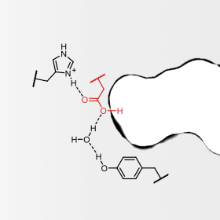Nature is often referred to as “the best and most creative chemist”, because of the development of highly specific synthetic processes which cannot be surpassed in terms of efficiency and effectiveness. The facilitation of biochemical reactions and intensification of development project activities with the aid of naturally occurring as well as engineered enzymes will help to further expand the portfolio of available biocatalysts. The use of single and multiple enzymes as catalysts for the preparation of novel compounds has received a steadily increasing amount of attention over the past few years.
Cascade reactions are of great importance in organic synthesis due to generation of important products in a single operation with high atom economy and bond-forming efficiency. The enzyme structure and design of its active site is important for catalytic activity and specificity in order to bind and convert particular substrates and to catalyze specific reactions. With the progress of molecular biology, biocatalysis has also emerged into a major area in biology. As part of our research efforts, we are continuously working on the development and improvement of new technologies allowing to further expand the toolbox of available biocatalysts to produce, modify and functionalize molecules of interest.
Ongoing Projects
Squalene-hopene cyclases (SHCs) are part of the terpene biosynthesis and catalyze the polycyclization from linear squalene to the pentacyclic products hopene and hopanol. This very precise catalysis is initiated by pre-folding of the linear substrate and subsequent protonation of the terminal carbon-carbon double bond by a Brønsted-acidic center in the enzyme active site. We have shown that SHCs are highly promiscuous and evolvable catalysts that accept a broad range of truncated and elongated terpenes and terpenoids. The general applicability in asymmetric Brønsted acid catalysis was demonstrated by catalyzing not only terpene cyclizations but also Friedel-Crafts alkylations, Prins reactions and challenging isomerizations. Consequently, SHCs are considered as protonases and we are currently evolving this enzyme for various interesting reactions in the field of asymmetric Brønsted-acid catalysis.
Further readings:
“Squalene hopene cyclases are protonases for stereoselective Brønsted acid catalysis” Hammer SC, Marjanovic A, Dominicus JM, Nestl BM, Hauer B, Nat Chem Biol 2015, 11, 121–126. Link
“Squalene hopene cyclases - evolution, dynamics and catalytic scope” Syrén P-O, Henche S, Eichler A, Nestl BM, Hauer B, Curr Opin Chem Biol 2016, 41, 73–82. Link
The selective dihydroxylation of olefins and aromatic compounds is a particular challenge in synthetic organic chemistry. Mono- and dihydroxylated chiral compounds are used especially as precursors for pharmaceuticals, fine chemicals and agrochemicals. Rieske non-heme iron oxygenases are promising catalysts for this chemistry as they catalyze the important stereoselective dihydroxylation and allylic oxidation of arenes and alkenes. The deeper understanding of the role of amino acid residues in the active site and adjacent loops is of high interest for further optimization of these oxygenases. Our research focuses on enzyme engineering of active site amino acids and active site loops to increase the activity, to alter the selectivity and substrate scope, and to utilize abiological cosubstrates for catalysis.
Further readings:
“Engineering Rieske Non-Heme Iron Oxygenases for the Asymmetric Dihydroxylation of Alkenes” Gally C, Nestl BM, Hauer B, Angew Chem Int Ed 2015, 54, 12952–12956. Link
“Semi-rational engineering of the naphthalene dioxygenase from pseudomonas sp. NCIB 9816-4 towards selective asymmetric dihydroxylation” Halder JM, Nestl BM, Hauer B: ChemCatChem 2017, 10, 178–182. Link
Cytochrome P450 monooxygenases (P450s) are versatile biocatalysts that catalyze the selective oxidation of non-activated hydrocarbons. Despite the great industrial interest in the hydroxylation of non-activated C-H bonds, this reaction continues to be challenging in chemical synthesis because of the harsh reaction conditions and poor selectivities. Remarkably, the P450 family CYP153A is known to hydroxylate linear alkanes and fatty acids selectively at the terminal position. We determined the crystal structures of two members of this family and discovered different substrate channels leading from the surface to the active site. Dynamic elements such as channels and loops are gaining more and more interest throughout the last years. In close cooperation with further research groups we want gain a deeper understanding of channels in P450 enzymes and how to change activity and specificity by addressing the substrate access and product egress.
Further readings:
“Structure-guided redesign of CYP153M.aq for the improved terminal hydroxylation of fatty acids” Hoffmann SM, Danesh-Azari HR, Spandolf C, Weissenborn MJ, Grogan G, Hauer B, ChemCatChem 2016, 8, 3234–3239. Link
“Unlocked potential of dynamic elements in protein structures: channels and loop” Kress N, Halder JM, Rapp LR, Hauer B, Curr. Opin. Chem. Biol. 2018, 47, 109–116. Link
Contact

Bernhard Hauer
Prof. Dr.Head of the Technical Biochemistry Department


